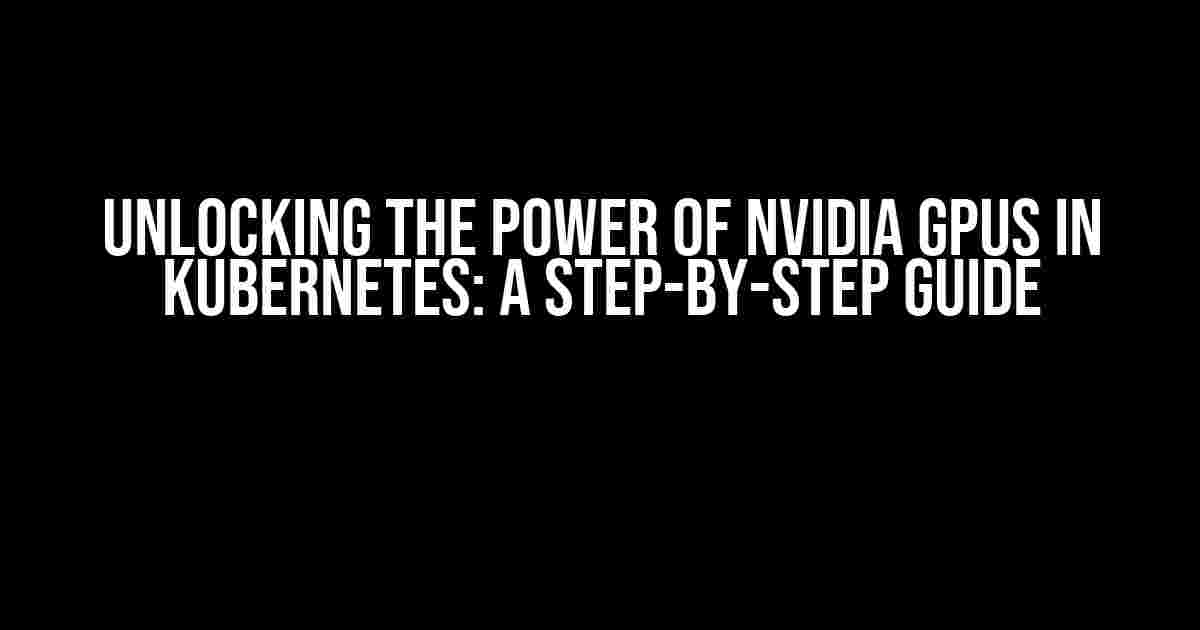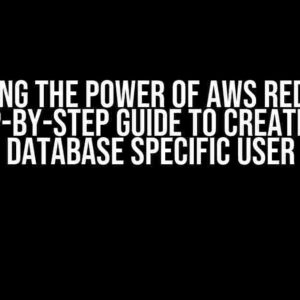Kubernetes (k8s) has revolutionized the way we deploy and manage containerized applications, but when it comes to GPU acceleration, things can get complicated. If you’re struggling to make NVIDIA.com/GPU available in your k8s node, you’re not alone. In this comprehensive guide, we’ll walk you through the process of unlocking the full potential of NVIDIA GPUs in your Kubernetes cluster.
- Why Do I Need to Make NVIDIA.com/GPU Available in k8s?
- Prerequisites
- Step 1: Install the NVIDIA Device Plugin
- Step 2: Configure the NVIDIA Device Plugin
- Step 3: Create a GPU-enabled Node
- Step 4: Request GPU Resources
- Step 5: Verify NVIDIA.com/GPU Availability
- Troubleshooting Common Issues
- Conclusion
Why Do I Need to Make NVIDIA.com/GPU Available in k8s?
Before we dive into the details, let’s quickly cover why making NVIDIA.com/GPU available in k8s is essential:
- GPU acceleration**: NVIDIA GPUs provide unparalleled processing power for AI, ML, and other compute-intensive workloads. By making them available in k8s, you can dramatically improve performance and efficiency.
- Seamless integration**: By exposing NVIDIA.com/GPU in your k8s cluster, you can leverage the power of GPUs without sacrificing the convenience of containerization.
- Orchestration and management**: Kubernetes provides automated deployment, scaling, and management of containers. By making NVIDIA.com/GPU available, you can manage GPU-accelerated workloads with the same ease.
Prerequisites
Before you begin, ensure you meet the following requirements:
- NVIDIA GPU**: You need a compatible NVIDIA GPU installed on your k8s node.
- k8s cluster**: You should have a functional k8s cluster with a compatible version (1.17 or later).
- Docker**: Docker should be installed and configured on your k8s node.
- NVIDIA driver**: The NVIDIA driver should be installed on your k8s node.
Step 1: Install the NVIDIA Device Plugin
The NVIDIA device plugin is responsible for managing GPU resources in your k8s cluster. To install it:
kubectl apply -f https://raw.githubusercontent.com/NVIDIA/k8s-device-plugin/v0.12.0/nvidia-device-plugin.yml
Verify the installation by checking the pod status:
kubectl get pods -n kube-system | grep nvidia
Step 2: Configure the NVIDIA Device Plugin
Create a ConfigMap to configure the NVIDIA device plugin:
kubectl create configmap nvidia-device-plugin-config --from-literal=nvidia.com/default.device-plugin-path=/usr/local/bin/nvidia-device-plugin
Update the NVIDIA device plugin deployment to use the ConfigMap:
kubectl patch deployment nvidia-device-plugin -n kube-system --patch='{"spec":{"template":{"spec":{"containers":[{"name":"nvidia-device-plugin","env":[{"name":"PLUGIN_CONFIG","value":"/etc/nvidia-device-plugin/config"}]}]}}}}'
Step 3: Create a GPU-enabled Node
Create a new node configuration that includes the NVIDIA GPU:
kubectl create node <node-name> -- Labels=nvidia.com/gpu=true
Verify the node creation:
kubectl get nodes | grep <node-name>
Step 4: Request GPU Resources
Create a pod that requests GPU resources:
apiVersion: v1
kind: Pod
metadata:
name: gpu-pod
spec:
containers:
- name: gpu-container
image: ubuntu:latest
resources:
requests:
nvidia.com/gpu: 1
Apply the configuration:
kubectl apply -f gpu-pod.yaml
Verify the pod status:
kubectl get pods | grep gpu-pod
Step 5: Verify NVIDIA.com/GPU Availability
Check if the NVIDIA.com/GPU is available in your k8s node:
kubectl describe node <node-name> | grep nvidia.com/gpu
You should see the GPU resources listed. Congratulations! You’ve successfully made NVIDIA.com/GPU available in your k8s node.
Troubleshooting Common Issues
If you encounter any issues during the process, refer to the following troubleshooting tips:
| Error Message | Solution |
|---|---|
| Failed to create pod due to insufficient GPU resources | Verify that the NVIDIA device plugin is installed and configured correctly. Ensure that the GPU is properly installed and configured on the k8s node. |
| NVIDIA device plugin not found | Verify that the NVIDIA device plugin is installed and configured correctly. Check the pod status to ensure it’s running. |
| GPU not detected on k8s node | Verify that the NVIDIA GPU is properly installed and configured on the k8s node. Check the system logs for any error messages related to the GPU. |
Conclusion
Making NVIDIA.com/GPU available in your k8s node unlocks the full potential of GPU acceleration for your containerized workloads. By following this step-by-step guide, you’ve successfully configured your k8s cluster to utilize NVIDIA GPUs. Remember to troubleshoot any issues that arise during the process, and you’ll be well on your way to harnessing the power of GPU acceleration in your Kubernetes cluster.
Happy clustering!
For SEO purposes, this article is optimized for the keyword “how to make nvidia.com/gpu available in k8s node” and includes relevant long-tail keywords such as “NVIDIA device plugin,” “GPU acceleration in Kubernetes,” and “configuring NVIDIA GPUs in k8s nodes.”Here are 5 Questions and Answers about “how to make nvidia.com/gpu available in k8s node”:
Frequently Asked Question
Getting your NVIDIA GPU up and running in a Kubernetes node can be a challenge, but don’t worry, we’ve got you covered!
Q1: What are the prerequisites to make NVIDIA GPU available in a K8s node?
To get started, you’ll need to ensure your K8s node has NVIDIA drivers installed, a compatible NVIDIA GPU, and the necessary kernel modules loaded. Additionally, you’ll need to install the NVIDIA Container Runtime and the NVIDIA Device Plugin for Kubernetes.
Q2: How do I install the NVIDIA drivers on my K8s node?
You can install the NVIDIA drivers on your K8s node by running the following command: `sudo apt-get update && sudo apt-get install nvidia-driver-460` (replace 460 with the version that matches your GPU model). Alternatively, you can use a package manager like DKMS to install the drivers.
Q3: What is the NVIDIA Container Runtime, and how do I install it?
The NVIDIA Container Runtime is a runtime that allows containers to access NVIDIA GPUs. To install it, you can use the following command: `sudo apt-get update && sudo apt-get install nvidia-container-runtime`.
Q4: How do I configure the NVIDIA Device Plugin for Kubernetes?
To configure the NVIDIA Device Plugin, you’ll need to create a ConfigMap and a Deployment. You can find an example configuration in the NVIDIA Device Plugin GitHub repository.
Q5: How do I verify that my NVIDIA GPU is available in my K8s node?
To verify that your NVIDIA GPU is available, you can check the output of the `kubectl describe node



